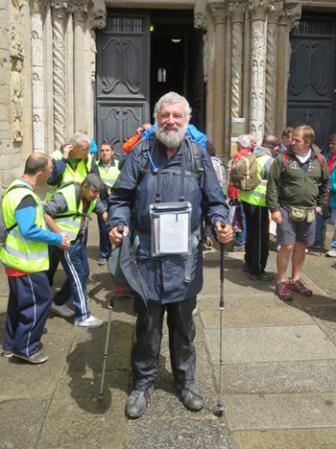In the past few months I have had the extraordinary privilege of visiting three of the four major Christian pilgrimage sites of mediaeval Europe. In March I visited Rome, where I prayed in the four basilicas, St Peter’s, St Paul’s, St John Lateran and St Mary Major. After Muslim rule extended over much of the Middle East in the 7th century, Christian pilgrimage to the Holy Land became more hazardous. Fortuitously, in the 9th century, the remains of the Apostle James were ‘discovered’ in northern Spain. The place was named St James after him, in Spanish, Santiago. In the following centuries it became the major place of pilgrimage for pilgrims from all over Europe.
After Muslim rule extended over much of the Middle East in the 7th century, Christian pilgrimage to the Holy Land became more hazardous. Fortuitously, in the 9th century, the remains of the Apostle James were ‘discovered’ in northern Spain. The place was named St James after him, in Spanish, Santiago. In the following centuries it became the major place of pilgrimage for pilgrims from all over Europe.
In recent decades the mediaeval practice has been revived. Each year a couple of hundred thousand pilgrims shoulder their packs to follow one of the ancient pilgrim paths to Santiago. In April and May, I was one such pilgrim, walking over 1,000kms from Granada to Santiago. This particular ‘way’ is called the Camino Mozarabe, as it passes through the territories that were once Muslim Spain.
In June I did a biblical formation programme at Ecce Homo in Jerusalem. It was a wonderful mix of input on the Gospel text and guided visits to sites in and around Jerusalem and beyond, including Galilee. I came away with a greater appreciation of the land considered holy by all three Abrahamic religions and its peoples.
I have been grieved by the violence unleashed in Israel-Palestine after I left. I am appalled by the atrocities committed in Iraq in recent weeks by the self-styled “Islamic State”. I am dismayed by the ongoing civil conflict in Syria. Together with Jewish, Christian and Muslim leaders, interfaith activists and all people of good will, I condemn the violence and appeal for peace with justice for all.
In these conflicts it is easy to blame one side or the other - but that does not help the situation.
Walking the pilgrim path in Spain, I was embarrassed by paintings and statues of Santiago Matamoros, Saint James and Killer of the Moors. But I was heartened by paintings and statues of Santiago Peregrino, St James the Pilgrim. I hasten to add that neither of these designations have anything to do with the Apostle James of history, but reflect the ecclesiastical, national and political interests of mediaeval times. I use this example to make the point that the Christian story has been used for spiritual reasons and for militant ones.
The same is happening today with Islam. The vast majority of Muslims around the world are good, decent, God-fearing, spiritually-motivated citizens striving for the common good; but a tiny minority violate cardinal principles of Islam for their own perverse ends, as is the case with Islamic State.
Christians and Muslims have shared histories, both in the geographic sense that we have lived together for centuries; and also in the sense that our religions, including our sacred texts, have been used for spiritual as well as for hegemonic purposes. Moreover, we share a common origin in God, a common pilgrim journey in this world, and a common destiny in God.
For all of these reasons, as Pope Francis has insisted, we are brothers and sisters. In these troubled times we need to stop the violence and to stand up for our common humanity, in the name of justice, in the name of peace, in the name of God.
This article was first published in the October 2014 edition of The Southern Cross, the official publication of the Catholic Archdiocese of Adelaide.
Rev Fr Patrick McInerney SSC is the Director of the Columban Mission Institute, Coordinator of its Centre for Mission Studies and Centre for Christian-Muslim Relations, and the Coordinator of Missiology at the Catholic Institute of Sydney.
Read more articles from the current E-News